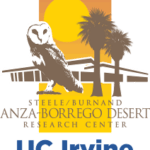
At 248,880 hectares (615,000 acres), Anza-Borrego Desert State Park is the largest state park in California and one of the largest desert protected areas in the west. Located in the eastern half of San Diego County, the park extends roughly 40 km (25 mi.) east to west and 80 km (50 mi.) north to south.
The Steele/Burnand Anza-Borrego Desert Research Center, housed in a former country club, is located adjacent to the park in the town of Borrego Springs. An agreement with Anza-Borrego Desert State Park and the Anza-Borrego Foundation makes the park available to reserve users.
Anza-Borrego Desert State Park encompasses a wide variety of habitats. High elevation species such as white fir grow on several mountaintops. Sonoran Desert stalwarts such as ocotillo, palo verde, fishhook cacti, and creosote are found in hotter, lower elevation areas. A perennial stream, Coyote Creek, offers rare riparian habitat within this arid region. Thirty fan palm oases, piñon pine and juniper forests, and live oak woodlands. The eroded formations of the Borrego and Carrizo Badlands are found in the eastern portion of the park.
The 932 plant taxa found in the park include a number of species unusual in California, such as the elephant tree more typical of Baja California. Late winter and early spring bring spectacular wildflower blooms and throngs of visitors. Approximately 320 bird species such as greater roadrunners and golden eagles are on the park checklist. Reptiles and amphibians include over 60 different species such as chuckwallas, desert iguanas, and the red diamond rattlesnake. The 60 species of mammals range from kit foxes and mule deer to the majority of the endangered desert bighorn sheep remaining in California.
Petroglyphs, pictographs, and other archaeological sites indicate that human habitation in the area began at least 6,000 years BP. In the late eighteenth century, Spanish explorers encountered settlements of Kumeyaay, Cahuilla, and other native peoples in the area. The Southern Emigrant Trail and the Butterfield Overland Mail Route, which brought many nineteenth-century migrants to the West, pass through the park. The park’s Begole Archeological Research Center houses maps and historical artifacts from all of these periods and is located near the reserve headquarters.
The Reserve is also used to support the Anza Borrego Foundation’s public service programs. The Foundation is a nonprofit that acquires land for conservation in and around the park, and supports research in the region, and is a reserve partner in public service programs.
-

- North America
- 401 Tilting T
- 2098
- BORREGO SPRINGS
- 92004
- United States
- California
- 33
- 116
- srood@uci.edu
- https://anzaborrego.ucnrs.org/
- 2012
- 2020
- Yes
- University of California at Irvine
- 260 Aldrich Hall
- Irvine
- 92697
- United States
- California
- Sicco Rood
- srood@uci.edu
- Field and Facilities Coordinator
- 401 Tilting T
- +17607671010
- Kirsten Dutcher
- dutcherk@uci.edu
- Luke Bui
- lukeb1@uci.edu
- info@upte-cwa.org
- $50,001 - $200,000
- 1-100
- Other
- Anza-Borrego Desert State Park and Anza-Borrego Foundation
- Yes
- Yes
- 1-2
- 0
- 21-50
- 51-100
- Yes
- Yes
- On Grid
- 61+
- Yes
- Yes
- Onsite public programs
- Yes
- Yes
- Yes
- Terrestrial
- Desert
- 101-300 meters
- 101-300 meters
- B (arid)
- Rural
- Yes
- Yes
- Yes
- Yes
- Yes
- Yes
- 40
- 10
- 40
- Year Founded
- 2012
- Year Joined OBFS
- 2020
- Size of Field Station (hectares)
- 1-100
- FSML Web Address
- https://anzaborrego.ucnrs.org/
- Private nonprofit organization?
- No
- Universities affiliated / Parent Organization
- University of California at Irvine
- Federal, state, or local governmental partners?
-
Other: Anza-Borrego Desert State Park and Anza-Borrego Foundation
- Member of the Virtual Field
- No

